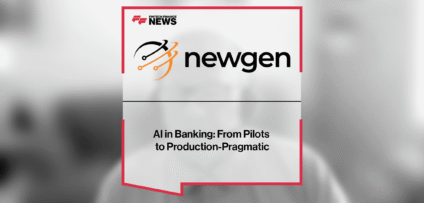Breaking News

The Mobile Payment Conundrum: Maintaining Trust without Compromising on Customer Experience
The world of personal finance continues to evolve rapidly, as consumers move away from their browsers and towards their smartphones when it comes to managing their bank balances. Mobile devices – as well as similarly popular items such as contactless debit cards – have been designed with this need for convenience, simplicity and ease of use in mind, and have become staple items of pockets and wallets across the country as a result.
However, recent figures from the Office for National Statistics’ latest crime survey underline the fact that this added convenience is not without its risks. Between March 2016 and March 2017, ‘cyber-related’ fraud constituted over half (57 per cent) of all fraudulent incidents, with 74 per cent of total incidents of this nature being categorised as ‘bank and credit account fraud’.
Convenience and ease of use are all well and good, but their benefits are rendered ineffective if a balance is not struck between trouble-free, instantaneous banking and watertight security. Data breaches can be costly not purely in a financial sense, but also in how a financial institution can lose the all-important trust of its customers.
This is where banks can feel as if they are in a catch-22 situation: increase security and you risk alienating your customers, but if you neglect security out of fear of compromising the user experience, you risk the consequences of cyber fraud. How can organisations achieve an adequate level of security and authentication to combat fraud and foster consumer trust, without interrupting the fast-paced lives of the modern user when it comes to personal banking?
The power of automation
In the event of fraudulent activity, one way for financial institutions to maintain trust is if they can inform their customers that an incident is being addressed, even before they become aware of it. This can take the form of proactive notifications or self-service tools – such as chatbots powered by natural language understanding – and can help to alleviate any customer concerns before they escalate. This is effective in communicating to the consumer that they are being protected at all times, and maintains trust by giving the customer some visibility of the security process.
An evolution in authentication
It is no secret that the traditional password alone is no longer fit for purpose, nor is a reliance on usernames or a requirement to memorise a combination of characters from a code. Users frequently employ passwords that are easy to break, and brute-force attacks by hackers are often able to overcome this hurdle with relative ease.
Despite this reality, research from Aspect in 2017 revealed that 88 per cent of consumers needed a combination of characters and digits to log into internet banking, and 85 per cent for mobile banking. It is time that financial institutions moved on and embraced more sophisticated methods, including multifactor authentication that incorporates security features such as biometrics. Without this, consumer trust remains at risk.
Marrying security with convenience
For increasingly demanding consumers, too much security slows down transactions and negatively affects the customer experience, while too little can open the door to fraudsters. One way to strike a balance between the two requirements is by adopting the verification method employed in SIM Swap detection. Crucially, this can be run imperceptibly to the customer, and offers an extra layer of authentication for complex transactions.
Divert and location detection tools are also useful in this regard, as they recognise when SMS messages are being diverted from the intended SIM card, and alerting customers through alternate channels. This process of layering verification offers the best currently available protection to fraud. However, it is also important to recognise that no method is entirely future-proof or foolproof: hackers are becoming more and more savvy when it comes to bypassing outdated security methods, so banks should always remain on their toes.
Know your customer (KYC)
The smartphone is rapidly developing into a viable form of user identification – something of a digital passport. Using these devices is an ideal way of embracing Know Your Customer (KYC) – the process of a business identifying and verifying the identity of its clients.
Using a smartphone as ID enables banks to gain rich data insights that they can use to accurately verify their users. Behavioural, operator and transactional insights can be collected and verified legitimately and with no disruption to the user experience, but in a way that increases security and further reduces the risk of fraud. It is unreasonable to expect users to put in extra effort to prove who they are just because fraudsters’ methods have become more sophisticated, so KYC can ensure that the user experience remains unchanged.
Progress through collaboration
The process behind increasing trust should not be a closed shop: banks need to work collectively to increase security without introducing more friction. This means that when financial institutions discover a mobile fraud attempt and have addressed the issue, they should then share information with the wider financial community so that similar incidents can be rapidly prevented across the board. They also need to do more to ensure that they are certain of a transacting party’s identity, which can be done through the analysis of mobile and behavioural data. Displaying a united front is essential in making consumers feel safe in the fact that the industry is working hard towards achieving better security, which in turn increases trust.
Ultimately, it is also paramount that each interaction is verified in a speedy and convenient manner, in a way that immediately spots when a genuine customer is making a transaction. This is where the advanced analytics solutions available on the market, combined with publicly available mobile data, can help make these efforts more effective and accurate than ever before.
Keiron Dalton, Global Program Senior Director, Aspect Verify
- FF Tattoo Studio: Vyntra on Keeping Instant Payments Real-Time and Safe Read more
- Bank of America on the Real Value of RTP Read more
- dLocal Partners With Alchemy Pay to Streamline Crypto-to-Fiat Payments in Latin America Read more
- AI in Banking: From Pilots to Production-Pragmatic Read more
- EXCLUSIVE: “Smarter Decisions. Smarter Operations” – Akber Jaffer, Smartstream in ‘The Paytech Magazine’ Read more















